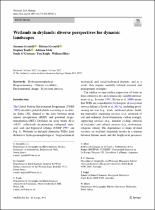Wetlands in drylands: Diverse perspectives for dynamic landscapes
| dc.contributor.author | Grenfell, Suzanne | |
| dc.contributor.author | Grenfell, Michael | |
| dc.contributor.author | Tooth, Stephen | |
| dc.date.accessioned | 2022-08-16T13:49:19Z | |
| dc.date.available | 2022-08-16T13:49:19Z | |
| dc.date.issued | 2022 | |
| dc.identifier.citation | Grenfell, S. et al.(2022). Wetlands in drylands: Diverse perspectives for dynamic landscapes. Wetlands Ecology and Management, 30(3). https://doi.org/10.1007/s11273-022-09887-z | en_US |
| dc.identifier.issn | 1572-9834 | |
| dc.identifier.uri | https://doi.org/10.1007/s11273-022-09887-z | |
| dc.identifier.uri | http://hdl.handle.net/10566/7743 | |
| dc.description.abstract | The United Nations Environment Programme (UNEP 1997) classifes global drylands according to an Aridity Index (AI), defned as the ratio between mean annual precipitation (MAP) and potential evapotranspiration (PET). Drylands are areas where AI is <0.65, collectively incorporating subhumid, semiarid, arid and hyperarid settings (UNEP 1997; see Fig. 1). Wetlands in drylands (hereafter WiDs) have distinctive hydrogeomorphological, biogeochemical, ecological, and social-ecological features, and as a result, they require carefully tailored research and management strategies. | en_US |
| dc.language.iso | en | en_US |
| dc.publisher | Springer | en_US |
| dc.subject | Hydrogeomorphology | en_US |
| dc.subject | Biogeochemistry | en_US |
| dc.subject | Ecosystem services | en_US |
| dc.subject | Medicinal plants | en_US |
| dc.subject | Water quality | en_US |
| dc.title | Wetlands in drylands: Diverse perspectives for dynamic landscapes | en_US |
| dc.type | Article | en_US |

